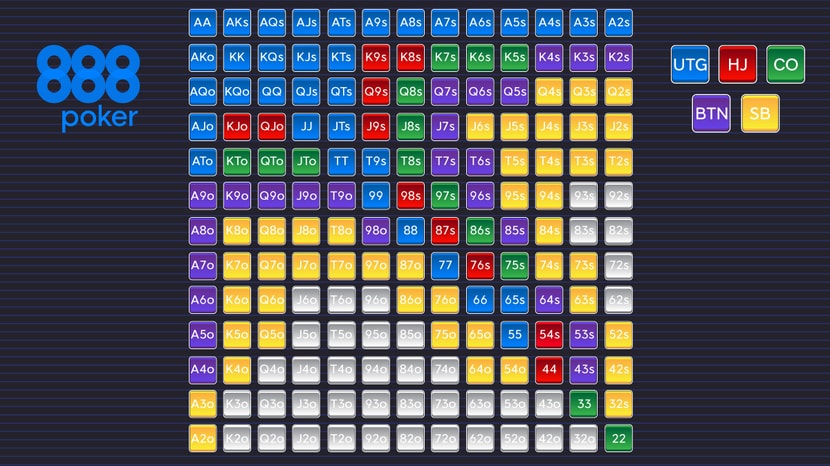Poker Strategy Hand Range Selection
Basic Starting Hands - Texas Hold'em
“What hands you play in Hold'em is as much about your position at the table as it is the hands yourself.
Here's a useful downloadable chart explaining hand rankings and what starting hands you should play. Click to download.
Poker Range relates to a set of hands that either you or an opponent might hold in a particular situation. So, instead of thinking of one holding like J♣10♦, you would include several hands in a range. For example – K9s, Q9s, J9s, etc. – is part of a poker range of hands. This concept is what we call a range in poker. Tournament strategy no-limit hold’em starting hand selection drawing hands blind defense value betting check-raising ranges range reading range advantage position Jonathan Little video; Related.
9-9, for example, is a good raising hand in late position if no-one has raised the pot beforehand, but in early position (the small or big blind) you can find yourself in trouble if you're first to act after the flop.
The first thing to do is group starting hands together: Premium, Semi-Premium and Marginal.
Premium hands are things like A-A and K-K. With these hands you'll be raising and re-raising, in every position at the table.
Next, Semi-Premium hands are ones like A-K, Q-Q, J-J, 10-10 and K-Qs. With these you should raise in every position, and re-raise with them in late position only. A-K is OK to just call a raise with in early position, as if you're first to act you can comfortably check-call on a low flop, or bet out if you've hit top-pair. Remember, A-K is only 'ace-high', i.e. it has great value only if you make a pair with it.
Next, Marginal hands are a bigger group of cards. In this group you can put 9-9, J-10s, 10-9s, A-10s, A-Js, K-Js. Raise in late position only in an unraised pot and call in early position if you have value.
This week I want to share an interesting hand in which I might have made a mistake (or two) by overplaying a strong hand.
The hand occurred relatively early in a $5,000 buy-in no-limit hold'em tournament. With the blinds 50/100 and everyone still around the starting stacks of 25,000, a tight-aggressive player in the hijack seat opened to 250 and it folded to me in the big blind where I called with .
That's an easy call with hand like that which can flop very well, and indeed the flop came to give me top pair and a gutshot straight draw. That said, as I explain in the video below, my TAG opponent who raised preflop and who likely has a lot of big cards in his range has a range advantage over me.

I checked, he checked behind, and the turn brought the to give me the straight.


Here I checked again, and my opponent bet rather big — 500 into a pot of 550. That bet suggested a polarized range (either total garbage or nut hands), but I nonetheless responded with a check-raise to 1,700. Looking back, this seems to me like a clear overplay of my hand and I should have just check-called.
In any case, my opponent called to make the pot about 4,000, then the river paired the board. Now what? Take a look at what I decided to do at this point and listen to how I explain my reasoning as well.
I went for value on river, another bet I don't like. Both the turn and river plays help illustrate a lesson — be careful not to overplay decently strong hands, especially when they've become marginal made hands.
Poker Strategy Hand Range Selection Strategy
Jonathan Little is a professional poker player and author with over $6,800,000 in live tournament earnings. He writes a weekly educational blog and hosts a podcast at JonathanLittlePoker.com. Sign up to learn poker from Jonathan for free at PokerCoaching.com. You can follow him on Twitter @JonathanLittle.
Poker Strategy Hand Range Selection Questions
Tags
tournament strategyno-limit hold’emstarting hand selectiondrawing handsblind defensevalue bettingcheck-raisingrangesrange readingrange advantagepositionJonathan LittlevideoRelated Players
Jonathan Little